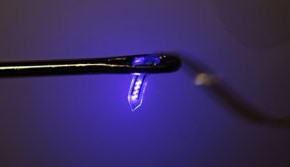Tiny Injectable LEDs Help Neuroscientists Study the Brain
December 10, 2013
on
on

Optogenetics is the process by which genetically-programmed neurons or other cells can be activated by subjecting them to light. Among other things, the technology helps scientists understand how the brain works, which could in turn lead to new treatments for brain disorders. Presently, fiber optic cables must be wired into the brains of test animals in order to deliver light to the desired regions. That may be about to change, however, as scientists have created tiny LEDs that can be injected into the brain.
The LEDs, developed by a team of researchers from the University of Illinois, can be as small as single cells and are printed onto the end of a flexible plastic ribbon that’s thinner than a human hair. Using a micro-injection needle, they can be injected precisely and deeply into the brain, with a minimum of disturbance to the brain tissue.
A wireless antenna and a rectifier circuit mounted on top of the subject’s head harvests radio frequency energy, which is fed down the ribbons to power the LEDs. This energy-harvesting module can be unplugged from the head when not needed. By contrast, when fiber optic cables are used, the animals must be tethered to a laser that provides the light.
The researchers have also developed a variety of other semiconductor microdevices that could be injected into the brain in the same fashion like heaters, temperature and light sensors, and electrodes capable of both stimulating and recording electrical activity. These could be injected into a variety of organs, not just the brain.
The LEDs, developed by a team of researchers from the University of Illinois, can be as small as single cells and are printed onto the end of a flexible plastic ribbon that’s thinner than a human hair. Using a micro-injection needle, they can be injected precisely and deeply into the brain, with a minimum of disturbance to the brain tissue.
A wireless antenna and a rectifier circuit mounted on top of the subject’s head harvests radio frequency energy, which is fed down the ribbons to power the LEDs. This energy-harvesting module can be unplugged from the head when not needed. By contrast, when fiber optic cables are used, the animals must be tethered to a laser that provides the light.
The researchers have also developed a variety of other semiconductor microdevices that could be injected into the brain in the same fashion like heaters, temperature and light sensors, and electrodes capable of both stimulating and recording electrical activity. These could be injected into a variety of organs, not just the brain.
Read full article
Hide full article


Discussion (0 comments)